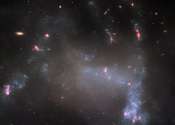Supermassive black hole appears to grow like a baby star
Supermassive black holes pose unanswered questions for astronomers around the world, not the least of which is "How do they grow so big?" Now, an international team of astronomers, including researchers from Chalmers University ...









